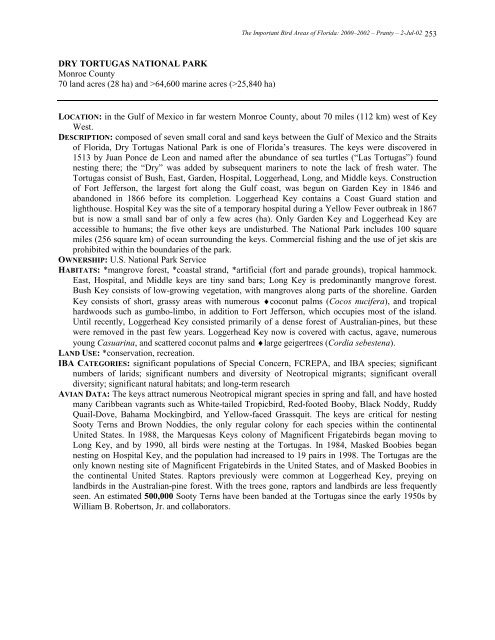The Important Bird Areas of Florida - National Audubon Society
The Important Bird Areas of Florida - National Audubon Society
The Important Bird Areas of Florida - National Audubon Society
Create successful ePaper yourself
Turn your PDF publications into a flip-book with our unique Google optimized e-Paper software.
<strong>The</strong> <strong>Important</strong> <strong>Bird</strong> <strong>Areas</strong> <strong>of</strong> <strong>Florida</strong>: 2000–2002 – Pranty – 2-Jul-02 253DRY TORTUGAS NATIONAL PARKMonroe County70 land acres (28 ha) and >64,600 marine acres (>25,840 ha)LOCATION: in the Gulf <strong>of</strong> Mexico in far western Monroe County, about 70 miles (112 km) west <strong>of</strong> KeyWest.DESCRIPTION: composed <strong>of</strong> seven small coral and sand keys between the Gulf <strong>of</strong> Mexico and the Straits<strong>of</strong> <strong>Florida</strong>, Dry Tortugas <strong>National</strong> Park is one <strong>of</strong> <strong>Florida</strong>’s treasures. <strong>The</strong> keys were discovered in1513 by Juan Ponce de Leon and named after the abundance <strong>of</strong> sea turtles (“Las Tortugas”) foundnesting there; the “Dry” was added by subsequent mariners to note the lack <strong>of</strong> fresh water. <strong>The</strong>Tortugas consist <strong>of</strong> Bush, East, Garden, Hospital, Loggerhead, Long, and Middle keys. Construction<strong>of</strong> Fort Jefferson, the largest fort along the Gulf coast, was begun on Garden Key in 1846 andabandoned in 1866 before its completion. Loggerhead Key contains a Coast Guard station andlighthouse. Hospital Key was the site <strong>of</strong> a temporary hospital during a Yellow Fever outbreak in 1867but is now a small sand bar <strong>of</strong> only a few acres (ha). Only Garden Key and Loggerhead Key areaccessible to humans; the five other keys are undisturbed. <strong>The</strong> <strong>National</strong> Park includes 100 squaremiles (256 square km) <strong>of</strong> ocean surrounding the keys. Commercial fishing and the use <strong>of</strong> jet skis areprohibited within the boundaries <strong>of</strong> the park.OWNERSHIP: U.S. <strong>National</strong> Park ServiceHABITATS: *mangrove forest, *coastal strand, *artificial (fort and parade grounds), tropical hammock.East, Hospital, and Middle keys are tiny sand bars; Long Key is predominantly mangrove forest.Bush Key consists <strong>of</strong> low-growing vegetation, with mangroves along parts <strong>of</strong> the shoreline. GardenKey consists <strong>of</strong> short, grassy areas with numerous ♦coconut palms (Cocos nucifera), and tropicalhardwoods such as gumbo-limbo, in addition to Fort Jefferson, which occupies most <strong>of</strong> the island.Until recently, Loggerhead Key consisted primarily <strong>of</strong> a dense forest <strong>of</strong> Australian-pines, but thesewere removed in the past few years. Loggerhead Key now is covered with cactus, agave, numerousyoung Casuarina, and scattered coconut palms and ♦large geigertrees (Cordia sebestena).LAND USE: *conservation, recreation.IBA CATEGORIES: significant populations <strong>of</strong> Special Concern, FCREPA, and IBA species; significantnumbers <strong>of</strong> larids; significant numbers and diversity <strong>of</strong> Neotropical migrants; significant overalldiversity; significant natural habitats; and long-term researchAVIAN DATA: <strong>The</strong> keys attract numerous Neotropical migrant species in spring and fall, and have hostedmany Caribbean vagrants such as White-tailed Tropicbird, Red-footed Booby, Black Noddy, RuddyQuail-Dove, Bahama Mockingbird, and Yellow-faced Grassquit. <strong>The</strong> keys are critical for nestingSooty Terns and Brown Noddies, the only regular colony for each species within the continentalUnited States. In 1988, the Marquesas Keys colony <strong>of</strong> Magnificent Frigatebirds began moving toLong Key, and by 1990, all birds were nesting at the Tortugas. In 1984, Masked Boobies begannesting on Hospital Key, and the population had increased to 19 pairs in 1998. <strong>The</strong> Tortugas are theonly known nesting site <strong>of</strong> Magnificent Frigatebirds in the United States, and <strong>of</strong> Masked Boobies inthe continental United States. Raptors previously were common at Loggerhead Key, preying onlandbirds in the Australian-pine forest. With the trees gone, raptors and landbirds are less frequentlyseen. An estimated 500,000 Sooty Terns have been banded at the Tortugas since the early 1950s byWilliam B. Robertson, Jr. and collaborators.
















